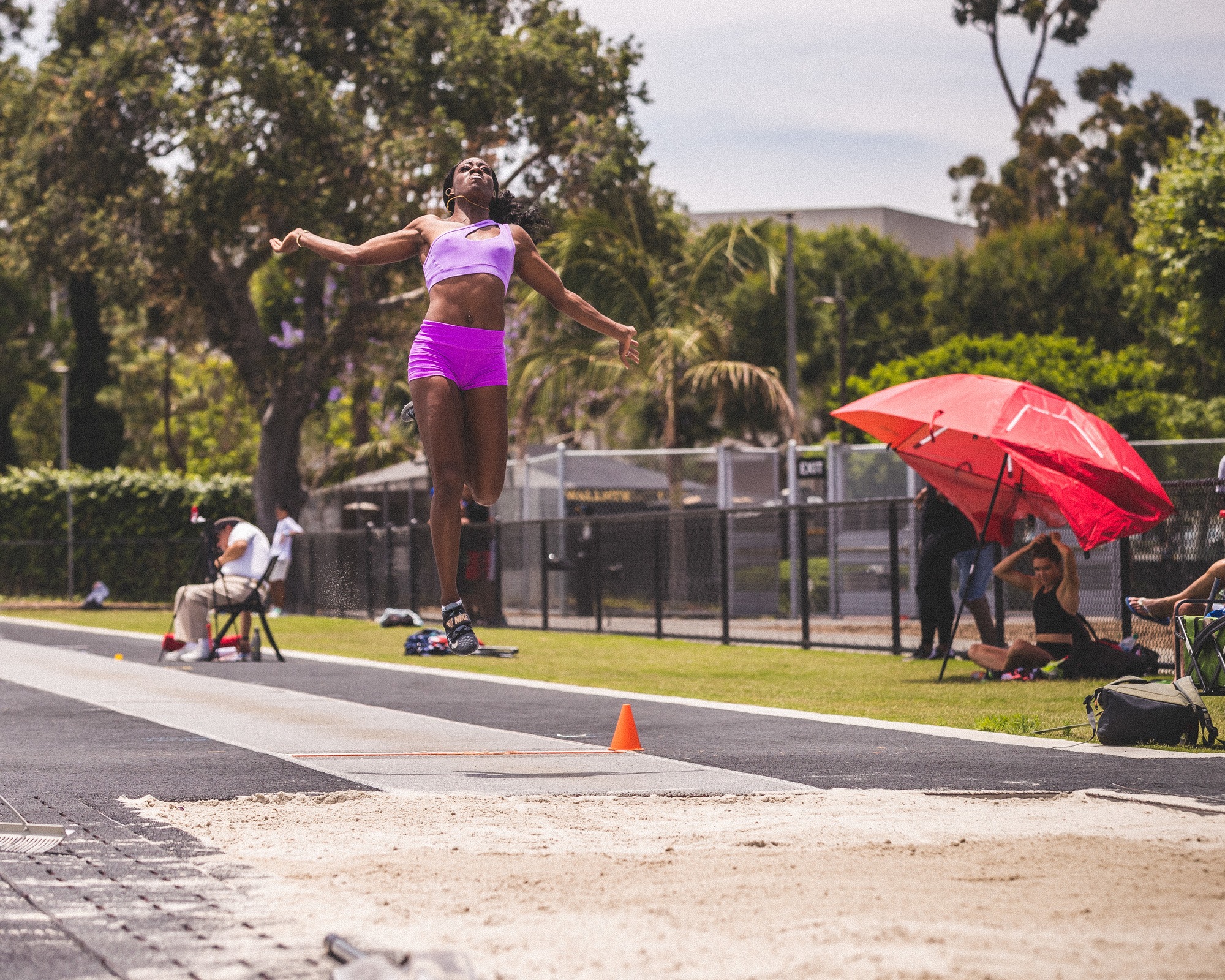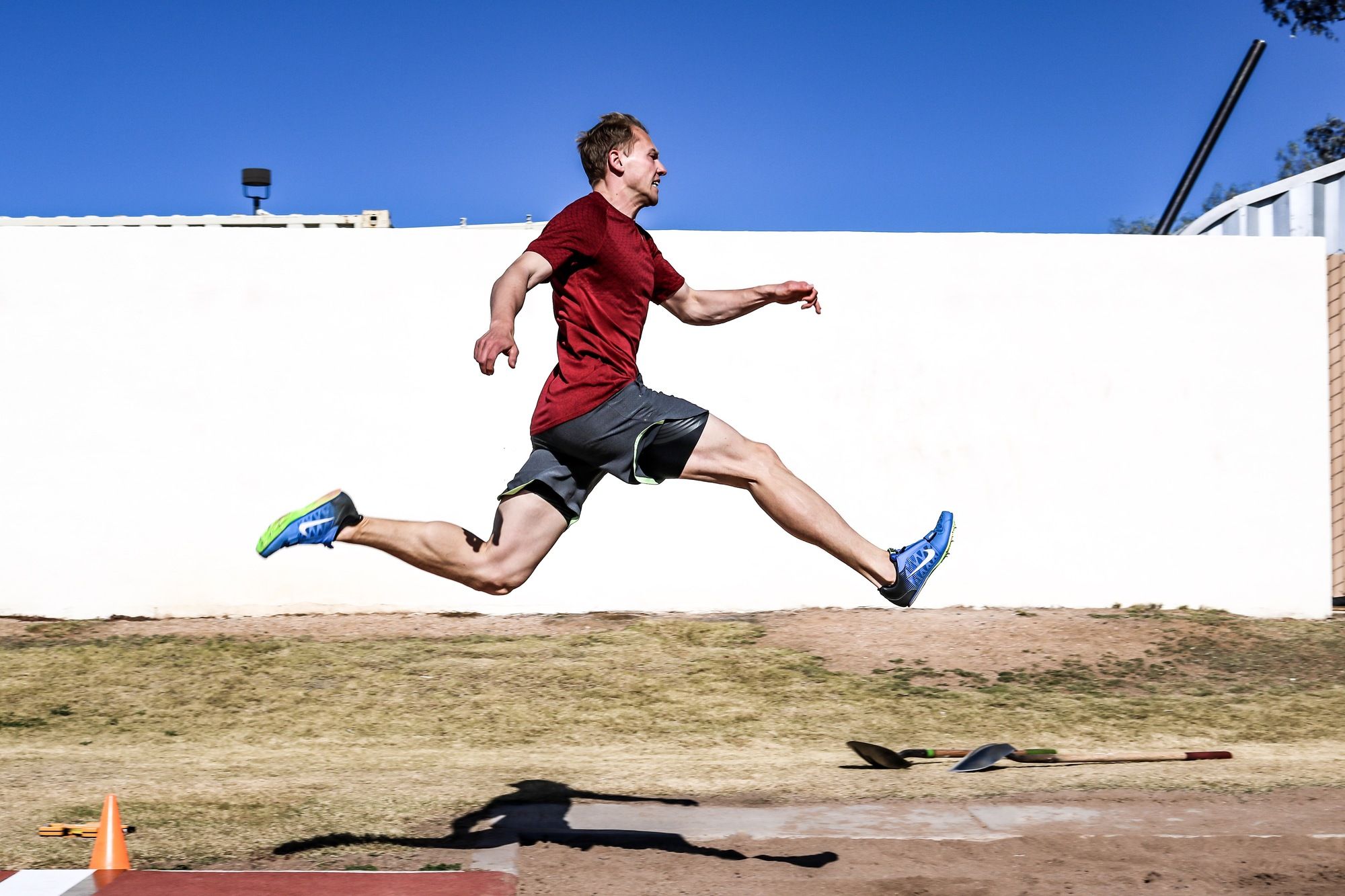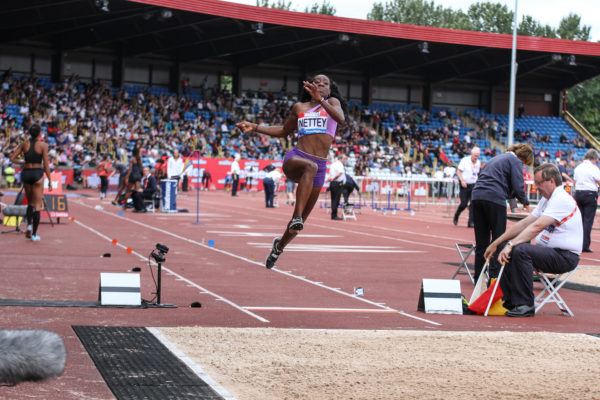THE TRANSITION PHASE
The final four steps of the approach comprise the transition phase.
Purposes of the Transition Phase
The transition phase of the horizontal jump approach has three purposes. They are:
- Preservation
- Facilitating the Steering Process
- Allowing Preparation and Positioning of the Body for Preparation and Takeoff
Preservation
While, the penultimate and takeoff steps in the horizontal jumps show subtle deviations from accepted sprint mechanics, our primary concern early in the transition phase is preservation of the mechanics expressed in the continuation phase. Velocity should be preserved. Undulation of the center of mass, oscillations of the pelvis, and large amplitudes of movement continue to produce valuable elastic energy. Vertical pushing should continue, meaning we should still see vertical shin angles prior to preparation and/or takeoff.
Facilitating the Steering Process
Many jumpers hit the board accurately and consistently, creating the illusion that their stride patterns are identical from jump to jump. The research of Dr. James Hay has shown that this is not the case at all. Jumpers accumulate accuracy errors and show variance through the first part of the approach, but in the final steps they begin to lengthen or shorten strides in order to hit the board. Every jumper, regardless of appearance, is altering stride lengths to some extent in the final steps. Hay’s research showed that these adjustments begin four steps away from the board, which is one reason why we designate the transition phase as the final four steps of the approach. This doesn’t mean that the approach should not be practiced for consistency. Our job as coaches is to help athletes to gain consistency so that these steering adjustments are small and not overly disruptive. In coaching the Long and Triple Jump approaches, we must understand and account for steering in our teaching practices and checkmark systems.
Coaching Practices
When coaching the transition phase, special attention needs to be paid to the steering process. Teaching steering in the transition phase requires the following approaches to training:
Teaching Visual Focus
Visual input provides the athletes’ tracking mechanisms with the data needed to steer effectively. Thus, teaching proper visual focus patterns is essential to steering facilitation. While the forward body lean associated with the start might prevent seeing the board, as soon as the jumper rises enough to see it, they should look directly at the board. During the continuation phase, the jumper should not drop the head to see the board, but should continue to look at it using the lower portion of their peripheral vision. Finally, when the jumper arrives at the transition phase, they have a feel of where the board is and how fast they are approaching it, and it should be easy for the body’s tracking mechanisms to place the foot on the board. This means the jumper loses sight of the board in the transition phase, but should still be able to easily locate it by trusting their inherent tracking ability.

Teaching proper visual focus patterns is essential to steering facilitation.
Teaching Steering Ability
The ability to effectively adjust stride lengths is trainable. Small but arbitrary movements of the starting checkmark in full approach or short approach jumping force steering and improve steering ability. Many of the typical drills and exercises we use in training daily can be used to train steering as well. For example, slight changes in spacing of hurdles in hurdle mobility work can help.
Using Checkmarks to Gauge the Degree of Steering
In addition to the starting checkmark, many coaches use a coach’s checkmark at the beginning of the transition phase, four steps from takeoff. This allows the coach to effectively gauge the length of those final four steps. The fact that the jumper hits the board has little or no bearing on whether or not the approach was accurate, because of the steering that takes place in those final steps.
For example, a jumper who hits the board accurately, but steps beyond the coaching checkmark, is shortening badly (and decelerating) in those final steps. This jumper needs to back up. In another situation, a jumper hits the board, but is behind the coaching checkmark. This jumper is actually reaching. In this case the starting checkmark can be moved forward, or the jumper can be encouraged to drive out of the back harder. In either case, the fact that the jumper hit the board had no bearing on whether the approach was accurate or not.
Allowing Preparation and Positioning of the Body for Takeoff
Philosophically, the transition phase isn’t a place to accelerate, but should be viewed as a place to position the body for takeoff. While subtle acceleration and frequency increase may occur, focus should be placed on positioning the body for preparation and takeoff. Exaggerated attempts to increase velocities will inevitably draw the body out of position.
Common Errors
One of the most prevalent errors in approach management is over aggressiveness in the transition phase. The jumper should view the drive and continuation phases as an opportunity to build momentum and velocity, but the transition phase should be viewed as a velocity maintenance phase. This is not to say that very subtle acceleration might not occur on the third and fourth to last steps, but biomechanical reports consistently show the best jumpers decelerating slightly in the final two steps. Efforts to accelerate or quicken stride cadence in the transition phase result in forward lean, decreased amplitudes of movement, anterior pelvic tilt, and possibly other problems as well.
In most cases, overaggressiveness in the transition phase is characterized by shin angles that shift forward (knee over the toe at touchdown). This is a helpful landmark for coaches evaluating this phase of the approach.

Coach Pfaff DISCUSSES global steering concepts and cueing the take off
Implications for practice
There are implications here for practice as well. In short approach jumping, regardless of the number of steps used, the final steps should be viewed the same way. Here Coach Schexnayder comments on runway distribution and the transition phase.
APPROACH MANAGEMENT & ACCURACY
Approach management is the process of observation, decision making, technical cuing, and checkmark management that help a jumper to remain consistently accurate throughout a practice or competition. This is a complex task, since the approach contains many variables that must be controlled to guarantee optimal velocity, body positions, and accuracy.
Stride Length/Frequency Relationships
In acceleration, stride length and frequency increase simultaneously, but are inversely proportional. When frequency increases too rapidly, stride length decreases and the approach falls short of the board. When frequency increases too slowly, stride length increases and the approach lengthens. When jumpers fall short of the board or reach, good coaching instincts guide us to decisions that will encourage patience in frequency development.
Stride Frequency Development
Frequency development must occur patiently at some optimal rate. When frequency increases too rapidly, momentum development and elastic energy production suffer. Excessive frequency decrease these ranges of motion, destroy accuracy, and actually decrease velocities.
When frequency increases too slowly, vertical velocity development and posture suffer. These jumpers have a hard time getting their feet underneath them and attaining upright postures.
Perhaps the most common error of developmental jumpers is simply trying to run too fast, generating too much frequency too soon. Young athletes often confuse the concepts of stride frequency and velocity. Stride frequency increases only increase velocity when they occur through high ranges of motion with good postures.

Coach Schexnayder comments further on the concepts discussed above
Drive Phase Management
The drive phase is the most common spot where stride frequencies vary, and even high level jumpers often struggle to keep the drive phase stride cadence slow under conditions of pressure and anxiety. The reverse is of course true in overpushing situations. Many problems at takeoff can be related to faulty drive phases. Failure to produce adequate momentum in the drive phase usually leads to overcompensation at takeoff, resulting in athletes who lower too much, reach, and become inaccurate.
Transition Phase Management
The displacement achieved in the jump is proportional to displacement achieved in the final strides. It’s a common error to decrease stride length in the transition phase. Displacement should remain great and stride length should be conserved in these final strides (within the context of good mechanics). Usage of the coach’s checkmark at the beginning of the transition phase can help the coach to ensure that the displacement in the final steps allows the best chances for big jumps.
Checkmark Management
Most good coaches approach a competition with a plan for moving the jumper’s starting checkmark during the competition. Some coaches might gradually back the jumper up, as aggressiveness builds and adrenaline kicks in. Some coaches might move the checkmark forward over the course of the competition. This is common with jumpers who tend to reach, placing them closer to the board makes it harder to do so. In any case, moving the mark back and forth during a competition in reaction to fouls and other circumstances is seldom productive. Jumpers steer, so most fouls result not from improper location of the checkmark, but because of technical errors that disrupt the body’s tracking processes. This is particularly true when the jumper fouls by similar amounts time and time again.

Coach Schexnayder comments on moving the checkmark in competition
Managing Wind
Headwinds and tailwinds can create approach management problems. The jumper should be coached to notice the wind conditions when stepping on the runway and adjust the starting mark appropriately based on the conditions at that time. Windy days require focus from jump to jump, since you never know when you’ll get a break from a headwind or a nice tailwind. Many a jumper has lost an opportunity for a great jump because poor wind conditions earlier in the competition have caused a loss of resolve and focus.

Headwinds and tailwinds can create approach management problems.
ACCURACY ISSUES: JUMPING FROM BEHIND THE BOARD
Habitually jumping from behind the board is a common accuracy related problem in the Long and Triple jumps. It usually results from decreases in elastic energy production in the final few steps of the approach. Here are some common causes:
Excessive Frequency Increases and Decreased Amplitudes of Movement
When jumpers try to increase stride frequencies and accelerate through takeoff, diminished amplitudes of movement and shorter strides result. The jumper’s steering processes had been previously accustomed to a certain expected stride length, and the jumper ends up behind the board as a result. Sometimes these frequency increases also disrupt posture, exacerbating the effect.
Diminished Undulation
Often as jumpers approach the board, the vertical push from each stride diminishes, and the pushoffs from each stride become more horizontally oriented. This results in less flight time between steps, and shorter steps. As a result, the jumper ends up behind the board. Changes in the shin angles in the transition phase of the approach are often a clue for the coach when this problem arises. Shin angles in the final steps normally start to tilt forward
Diminished Oscillation
It’s a common error to see Long and Triple jumpers stop these oscillations, tightening up the hips in the final few steps of the approach as they anticipate takeoff. This causes stride lengths in the transition phase to decrease, and the jumper ends up behind the board.
It’s important to note that in each of these cases, moving the starting checkmark forward will only create bigger problems. Misreading this and moving the checkmark forward in compensation will only have the jumper feel more crowded and exacerbate the situation. The answer in all of these situations is to encourage relaxation and maintenance of these elastic energy generating tools through takeoff.

Habitually jumping from behind the board is a common accuracy related problem in the Long and Triple jumps.
BATTLING FOULS
Fouling has historically derailed many jumpers over time, and the presence of the scratch line certainly complicates the event. However, fouls occur for specific reasons. Following are some of the more typical technical mistakes that result in fouls:
Faulty Drive Phases
Failure to produce adequate momentum in the drive phase usually leads to compensation at takeoff, resulting in athletes who lower too much or reach at takeoff.
Poor Posture
Anterior pelvic tilt and/or negative shin angles introduce excessive instability into the approach. The body inherently reacts with grounding strategies, advancing the location of foot contacts, resulting in a foul.
Deceleration
Deceleration, particularly on the penultimate step, result in a disrupted undulatory path of the body’s center of mass, typically bouncing the jumper over the board and resulting in a foul.
Reaching
Jumpers who reach lose the ability to effectively track, since the feet are normally contacting the track out in front of the center of mass. So yes, it is a frequent occurrence that an athlete who fouls might actually have to move the checkmark forward in order to solve the problem. This often creates an emotional dilemma for the jumper, but is actually a fairly common occurrence.

Deceleration, particularly on the penultimate step, result in a disrupted undulatory path of the body’s center of mass.
TECHNICAL IMPROVEMENTS – IS FOULING EVER GOOD?
Many coaches have been faced with the dilemma of athletes who jump well, but foul the really big ones. Improvements in technique and posture result in changes in depth perception and tracking, so this circumstance is common. The good news is that repetition typically retrains the body’s tracking mechanisms and more often than not, those big jumps become legal ones. Most experienced coaches have never coached anyone who didn’t foul a few big ones before eventually placing them on the scorecard.
Target Choice
Although not a permanent solution, when an athlete is jumping well and fouling, choosing a different target might help. Having the athlete steer for the back half of the board might cost a few inches or centimeters, but often produces legal jumps. As a general rule, when athletes are fouling and jumping poorly, fix the jump. When they are jumping well and fouling, change the target.
Training Culture
Finally, the culture of your training environment dictates much of your jumper’s attitudes toward fouls. Jumpers should be taught to be accountable for their fouls. They should understand that the approach doesn’t put them on the board, but that the approach only puts you close to the board. It’s the jumpers’ job to place themselves on the board. They should understand that fouls happen for reasons that are within their control. Jumpers should jump from boards in training, and excessive fouling in training should not be allowed.

Fouling has historically derailed many jumpers over time.

- The horizontal jump approach develops horizontal velocity, ensures accuracy, and positions the jumper’s body physically to execute preparation and takeoff well
- Choosing the number of steps the jumper will use in the approach is a major decision, and many factors such as experience levels, talent levels, age, and technical consistency all play a role in this decision
- The four phases of the approach are the start, the drive phase, the continuation phase, and the transition phase
- The start should be mechanically sound and consistently repeatable
- The drive phase serves to develop momentum and achieve good body positions, particularly good pelvic alignment
- The continuation phase exhibits maximal velocity mechanics and shows continued, gradual acceleration
- The transition phase presents certain coaching challenges. Jumpers often commit errors in anticipation of takeoff. Also, it is in the transition phase that steering takes place
- Runway management consists of the coaching practices used to help a jumper achieve and maintain accuracy in training and competition
- Most fouls result from technical faults or mistakes, rather than error in checkmark placement

- Accuracy
- Steering
- Crouch Start
- Rollover Start
- Checkmark
- Foul

Reading: Mechanics of the Jump Approach
Reading: Lowering the center of mass for the Triple Jump takeoff
Reading: Evaluating the approach run of class F11 visually impaired athletes in Triple and Long jumps
Reading: Effect of approach run velocity on the optimal performance of the Triple Jump
Reading: Step adjustment in the Long Jump approach in beginner athletes
Reading: Jarver, Jess. Editor. The Jumps. Contemporary Theory, Technique and Training. (4th Edition) Track and Field News Press. Los Altos, 1994
Reading: Jacoby, E. & Fraley, B. Complete Book of Jumps. Champaign, Human Kinetics, 1995
Reading: Techniques used by elite Long Jumpers in preparation for takeoff
Reading: Approach strategies in the Long Jump

